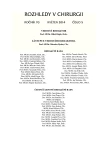Multiple trauma – treatment of skeletal injuries with damage control orthopaedics
Authors:
M. Šír 1,2; L. Pleva 1,2; V. Procházka 3
Authors‘ workplace:
Traumatologické centrum FN Ostrava, primář: Doc. MUDr. L. Pleva, CSc.
1; Ústav medicíny katastrof, Lékařská fakulta OU, vedoucí ústavu: Doc. MUDr. L. Pleva CSc.
2; Radiodiagnostický ústav FN Ostrava, přednosta: Doc. MUDr. P. Krupa, CSc.
3
Published in:
Rozhl. Chir., 2014, roč. 93, č. 5, s. 287-291.
Category:
Various Specialization
Práce je určena k postgraduálnímu vzdělávání lékařů.
Overview
New methods of treating seriously injured patients have been introduced in the field of trauma surgery since 1993. These consist mostly of differentiated and rapid procedures of treatment of the injured skeleton, with the aim of preventing the development of severe haemorrhagic shock and exsanguination of the patient. The precondition for introducing these techniques is the study of the organism’s inflammatory response to trauma. Since 2000, this approach has been called damage control orthopaedics. The authors deal with the history of this method, the physiology of severe trauma, selection of patients eligible for this method and the appropriate timing of definitive treatment.
Key words:
multiple trauma – skeletal injuries – external fixators
Sources
1. Roberts S, Pape H, Jones A, Malkani A, Rodriguez J, et al. Damage control orthopaedics. J Bone Joint Surg Am 2005;87-A:434–449.
2. Pleva L, Klus I. Metody damage control úrazové chirurgie u polytraumat. Úraz Chir 2004;12 : 1–5.
3. Pleva L, Mayzlík J. Metoda damage control surgery and orthopaedics. Novinky v anesteziologii, intenzivní medicíně a léčbě bolesti 2007;57.
4. Bradford DS, Foster RR, Nossel HL. Coagulation alterations, hypoxemia, and fat embolism in fracture patients. J Trauma. 1970;10 : 307–21.
5. Bone LB, Johnson KD, Weigelt J, Scheinberg R. Early versus delayded stabilisation of femoral fractures. J Bone Joint Surg Am 1989;71-A:336–340.
6. Border JR. Blunt multiple trauma: comprehensive pathophysiology and care. New York, Marcel Dekker 1990.
7. Smith RM, Giannoudis PV. Trauma and the immune response. J R Soc Med 1998;91 : 417–420.
8. Pape HC, Schmidt RE, Rice J, van Griensven M, das Gupta R, et al. Biochemical changes after trauma and skeletal surgery of the lower extremity: quantification of the operative burden. Crit Care Med 2000;28 : 3441–8.
9. Copeland CE, Mitchell KA, Brumback RJ, Gens DR. Burgess AR. Mortality in patiens with bilateral femoral fractures. J Orthop Trauma 1998;12 : 315–319.
10. Agolini SF, Shah K, Jaffe J, Newcomb J, Rhodes M, et al. Arterial embolization is a rapid and effective technique for controlling pelvic fracture haemorrhage. J Trauma 1997;43 : 395–399.
11. Pohlemann T, Gansslen A, Bosch U, Tscherne H. The technique of packing for control of haemorrhage in complex pelvic fractures. Tech Orthop 1995;9 : 267–70.
12. Greenspan L, McLellan BA, Greig H. Abbreviated injury scale and injury severity score: a scoring chart. J Trauma 1985;25 : 60–64.
13. Dunham CM, Bosse MJ, Clancy TV, Cole FE, Jr, Coles MJ, et al. Practice guidelines for the optimal timing of long bone fracture stabilisation in polytrauma patient: The EAST Practise Management Guidelines Work Group. J Trauma 2001;50 : 958–67.
14. Giannoudis PV, Smith RM, Bellamy MC, Morrison JF, Dickson RA, et al. Stimulation of the inflammatory system by reamed and unreamed nailing of femoral fractures An analysis of the second hit. JBJS Br 1999;81 : 356–61.
15. Scalea TM, Boswell SA, Scott JD, Mitchell KA, Kramer ME, et al. External fixator as a bridge to intramedullary nailing for patiens with multiple injuries and femur fractures: damage control orthopaedics. J Trauma 2000;48 : 613–623.
16. Hofman PA, Goris RJ. Timing of osteosynthesis of major fractures in patiens with severe brain injury. J Trauma 1991;31 : 261–3.
17. Pape HC, van Griensven M, Rice J, Gansslen A, Hildebrand F, et al. Major secondary surgery in blunt trauma patiens and perioperative cytokine liberation, determination of the clinical relevance of biochemical markers. J Trauma 2001;50 : 989–1000.
18. Pape HC, Giannoudis P, Krettek C. The timing of fracture treatment in polytrauma patiens relevance of damage control orthopedic surgery. Am J Surg 2002;183 : 622–629.
19. Cuence AG, Maier RV, Cuschieri J, Moore EE, Moldawer LL, et al. The glue grant experience: characterizing the post injury genomic response. Eur J Trauma Surg 2011;37 : 549–558.
Labels
Surgery Orthopaedics Trauma surgeryArticle was published in
Perspectives in Surgery

2014 Issue 5
Most read in this issue
- Complications after percutaneous transhepatic drainage of the biliary tract
- Superficial thrombophlebitis of the lower limbs from the surgeon’s point of view
- Pelvic ring injury as part of multiple trauma
- Retroperitoneal neurogenous tumors
